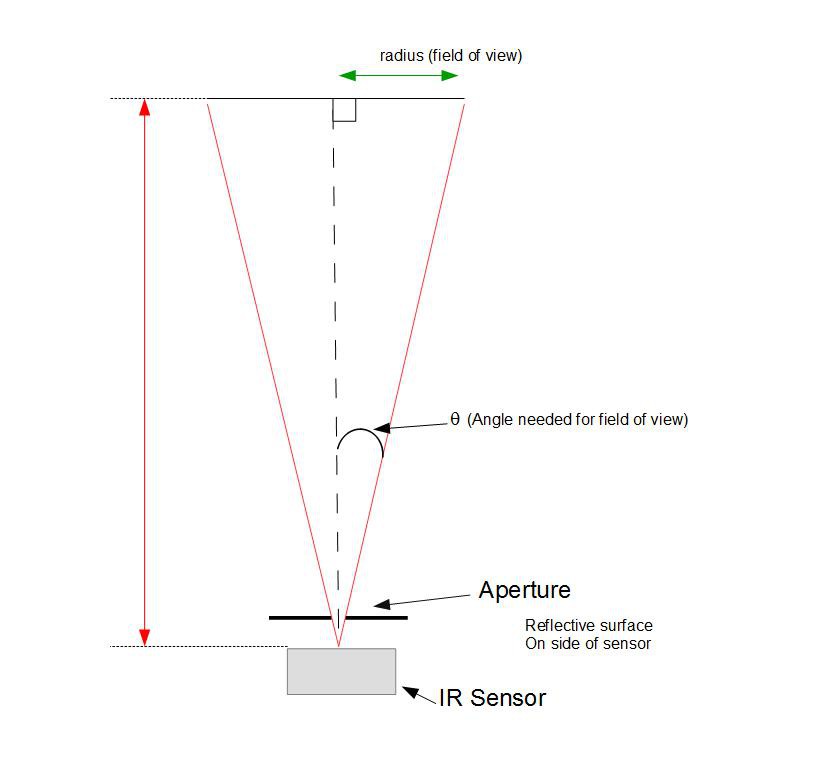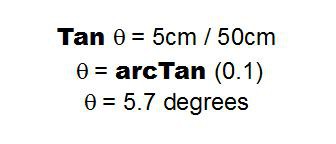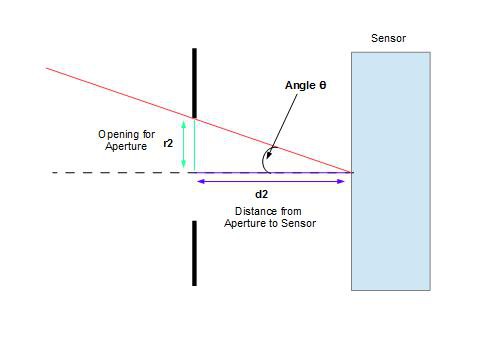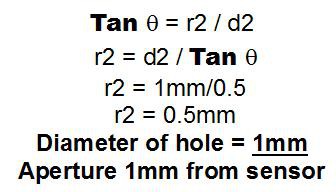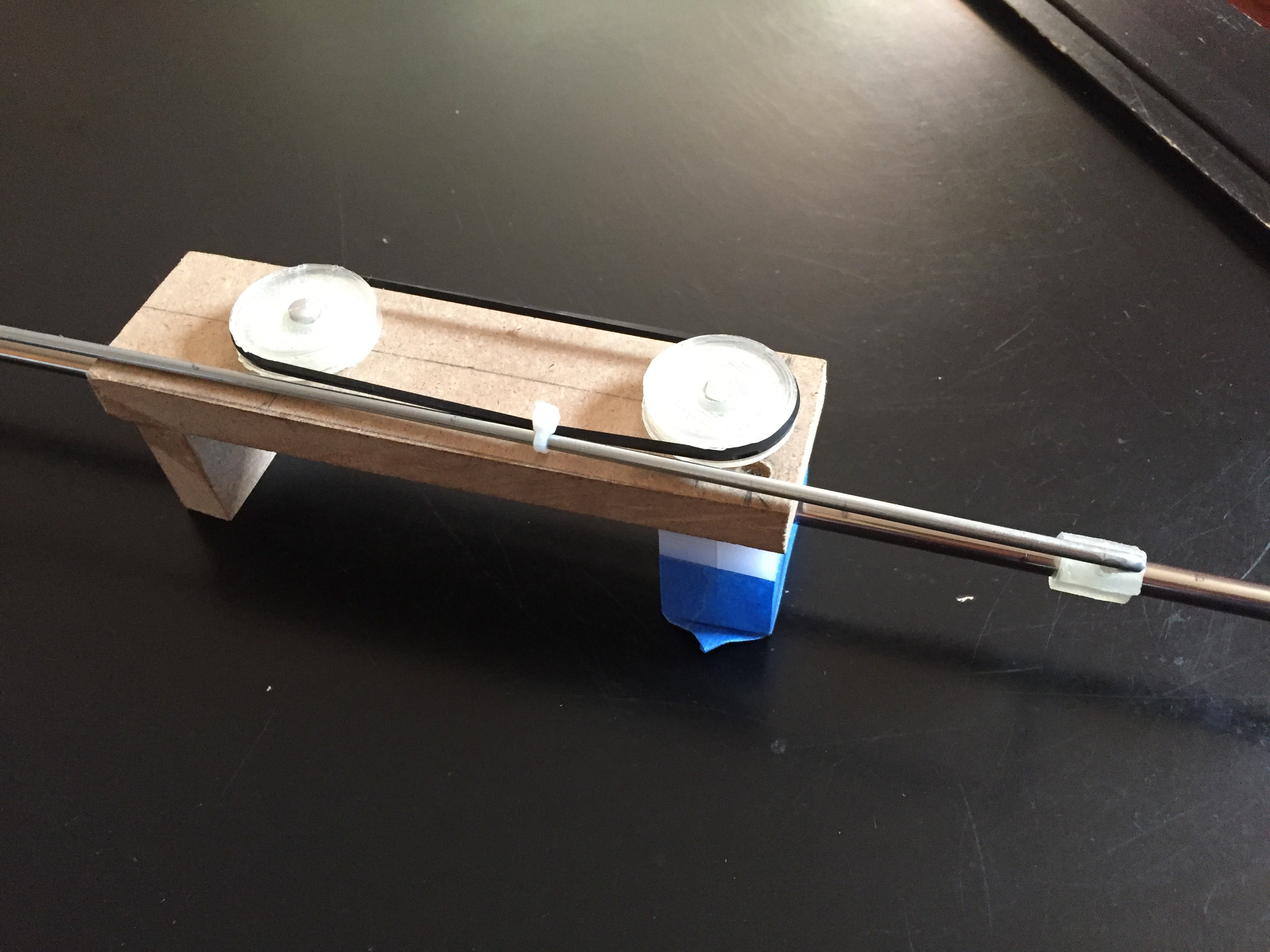-
Blush Sensor
02/21/2017 at 05:53 • 0 commentsCurrently I'm using the GY-906 (off eBay) MLX90614 - non-contact IR temperature sensor breakout board. I chose this sensor mainly because it had a smaller field of view than Texas Instruments TMP006 sensor. Adafruit has tutorial's and libraries for both of these sensors (here's the link for the MLX90614 Adafruit Tutorial and Arduino Libraries).
My initial tests for this sensor worked flawlessly - no issues with communication through an Arduino and sensor reacted as anticipated to different temperature gradients.
While I can't find my bookmark for it, TI has a tutorial on limiting the field of view of their TMP006 sensor and I'm using that information to attempt to do the same with the MLX90614. Their approach is fairly simple and straight forward though it does require simple measurements and a little bit of trigonometry.
Below is an illustration of the basic concept:
To make it a bit easier to understand (conceptually) I rotated the view 90 degrees:![]()
The field of view is circular with a radius of "r1" for my purposes I'm using a radius, for the field of view, of 5cm (so a circle with a diameter of 10cm - basically want to view the cheeks on the face of the subject). As a starting point I'm using 50cm as the distance from the sensor to the subjects face. This gives us:![]()
Once we know the required angle we just need to figure the size of the hole for the aperture and how far away it needs to be from the sensor:![]()
The needed angle (5.7 degrees) was calculated above now we only have to plug in the distance from the aperture that we want, then we'll have the radius hole we need (just double that to get the diameter).![]()
For the aperture I plan to use some thin aluminum sheet and polish the side facing the sensor. I'll start testing this part tomorrow to see if it works in the way I'm hoping it will.![]()
-
Arm Extension
02/10/2017 at 21:43 • 0 commentsThis is a short video I shot demonstrating the arm extension mechanism on the Voight-Kampff.
The 2 pulley wheels and the coupling attaching the rods together I designed and 3D printed for this test, the thicker metal rod is a 7mm guide rod salvaged from an old scanner auicnd the thinner rod was taken from a pants hanger (it ran through the 2 clips on the hanger). For a quick and easy bushing for the rod to slide through I used HDPE (from kitchen cutting board).
Still picture of test:
-
References
02/07/2017 at 08:46 • 0 commentsI feel the need to always include a section of any project related to references, including: inspiration, datasheets, application notes.
LED Bar Graph Displays:
- Arduino LED Bar Graph with a 4017 Counter and Potentiometer http://codetronix.com/2011/06/05/arduino-led-bar-graph-with-a-4017-counter-and-potentiometer/
Emotion and Physiology
- Neuro-Tools: Emotion Detection January 16, 2017 https://acuityets.wordpress.com/2017/01/16/neuro-tools-emotion-detection/ accessed 3/28/17
- Broek E, Schut MH, Westerink J, Tuinenbrejier K. Unobtrusive Sensing of Emotion (USE). Journal Of Ambient Intelligence and Smart Environments (2009) 287-299.
- Kreiberg S, Autonomic nervous system in emotion: A Review. Biological Psychology 84(2010) 394-421
- Levenson RW, The Autonomic Nervous System and Emotion. Emotion Review, vol , no. (April 2014) 100-112.
Heart Rate Detection (ECG and Photoplysmography)
- Texas Instruments Application Report SLAA655-March 2015
- How to Design Peripheral Oxygen Saturation (SpO2) and Optical Heart Rate Monitoring (OHRM) Using the AFE4403
- Arduino Measures Heart Beat Rate From Fingertip http://embedded-lab.com/blog/arduino-heart-rate-meter-seven-segment-led-display/
- http://makezine.com/projects/ir-pulse-sensor/
GSR/EDA
- A Wearable Sensor for Unobtrusive, Long-Term Assessment of Electrodermal Activity. IEEE Transactions on Biomedical Engineering. Vol. 57 No.5 May 2010.
- https://hackaday.io/projects/6701/logs LMV324 for GSR/EDA
- https://www.etc.cmu.edu/projects/biofeedback/research/gsr.doc
- ttp://www.trans4mind.com/psychotechnics/gsr.html
- https://www.media.mit.edu/galvacticator/faq.html
Heart Rate Variability
- Goss CF & Miller FB. Dynamic metrics of heart rate variability. August 29, 2013, 4 pages. ArXiv:1308.6018.
- Lee C, Yoo SK, Park Y, Kim N, Jeong L, Lee B. Using Neural Network to Recognize Human Emotions from Heart Rate Variability and Skin Resistance. Proceedings of the 2005 IEEE, Engineering in Medicine and Biology 27th Annual Conference, Shanghai China, Sept. 1-4,2005. p5523-5525
- Bailon R, Laouini G, Groa C, Orini M, Laguna P, Meste O. The Integral Pulse Frequency Modulation Model with Time Varying Threshold: Application to Heart Rate Variability Analysis During Exercise Stress Testing. IEEE Transactions on Biomedical Engineering, Vol 58, No 3 March 2011. p642-652
- Linares L, Medez AJ, Lado MJ, Oliviera DN, Vila XA, Conde I. An open source tool for heart rate variability spectral analysis. Computer Methods and Programs in Biomedicine 103 (2011) 39-50
- Zhao M, Adib F, Katabi D. Emotion Recognition using Wireless Signals. MobiCom'16, Oct 3-7, 2016 http://dx.doi/10.1145/29373750.2973762
- Valderas MT, Bolea J, Laguna P, Vallverdu M, Bailon R. Human emotion recognition using heart rate variability analysis with spectral bands based on respiration.
- Lane RD, McRae K, Reiman EM, Chen K, Athern GL, Thayer JF. Neural correlates of heart rate variability during emotion. NeroImage 44 (2009) 213-222
- Orini M, Bailon R, Enk R, Koelsch S, Mainardi L, Laguna P. A method for continuously assessing the autonomic response to music-induced emotions through HRV analysis. Med Biol Eng Comput (2010) 48-423-433
- Williams DP, Cash C, Rankin C, Bernardi A, Koenig J, Thayer JF. Resting heart rate variability predicts self-reported difficulties in emotion regulation: a focus on different facets of emotion regulation. Frontiers in Psychology, March 2015, vol 6, article 261
- Valenza G, Citi L, Lanata A, Scilingo EP, Barbieri R. Revealing Real-Time Emotional Responses: a Personalized Assessment based on Heartbeat Dynamics. Scientific Reports, 4:4998, DOI: 10.1038/srep04998
Movie References:
Leon's VK test
Rachel's VK test
Book References
"Do Androids Dream of Electric Sheep" Philip K. DickTechnical References:
-
Voight-Kampff - the beginning
02/05/2017 at 07:23 • 0 commentsMy objective is to build a functional Voight-Kampff machine from the classic Sci-Fi Movie Blade Runner.
Leon's Voight-Kampff test
Rachel's Voight-Kampff test
Currently, I'm working on developing the software, integration of sensors and the actual body of the machine.
My plan is to exhibit this project at the Chicago 2017 Maker Faire.
I have much of the mechanics (arm raise, extension, and rotation of the eye sensor) worked out using servos and micro-controllers.
My current design calls for using a Raspberry Pi as the central processor for the VK. The sensors that I'm currently working on integrating are:
- Metexis MLX90614 Non-contact Temperature sensor (for Blush response)
- Raspberry Pi NoIR Camera Board v2
- using software adapted from PyGaze to measure pupil dilation/constriction
- Separate hand held module for test
subject containing:
- MAX30100 pulse ox sensor
- Galvanic Skin Response Sensor
I aim to have it all contained in the classic Voight-Kampff machine with read outs from the sensors going to the 3 separate monitors (and the 2 LED Bar Graphs).
 Tom Meehan
Tom Meehan